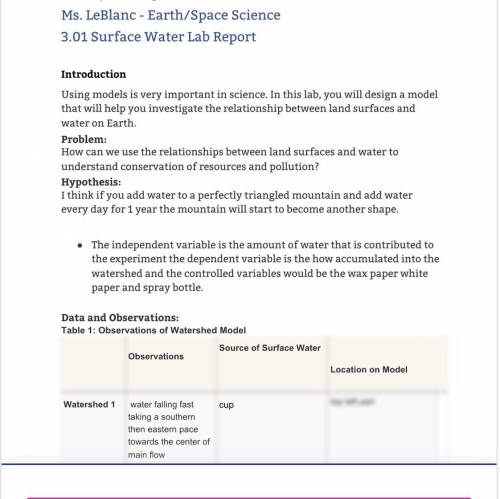Surface Water Lab Report
Introduction
Using models is very important in science. In this lab,...

Surface Water Lab Report
Introduction
Using models is very important in science. In this lab, you will design a model that will help you investigate the relationship between land surfaces and water on Earth.
Problem:
How can we use the relationships between land surfaces and water to understand conservation of resources and pollution?
Hypothesis:
After completing steps 1 through 5 in your procedures, predict the number and locations of watersheds that will form in your watershed model.
For example:
Based on the positions of landscape features in my watershed model, I predict there will be ___3 number of watersheds located at these locations in my model: close to the top, in the center, and the right side.
Materials:
If you would like to create your watershed model by hand, you will need the materials listed.
Note: There are alternative procedures that do not require these materials.
one sheet of plain white paper
several sheets of old newspaper, or wax paper if available
one water-based marker (Note: do not use permanent marker)
one spray bottle containing water (place on “mist” setting)
digital camera, if available
Procedures:
Place several sheets of newspaper or wax paper over a large flat surface, such as a kitchen counter. Use at least five sheets of paper so that you can protect your work area.
Crumple the sheet of white paper into a loose wad.
Uncrumple the sheet of paper so you can lay it on your work surface. The paper should not be flat but should be wrinkled and puffed up from the crumpling.
Imagine the paper as a miniaturized version of mountains, hills, valleys, and other landscape features. If your paper is so flat that you can't imagine these features, you should recrumple it.
Use the marker to color the major folds or ridges in the paper, as well as some of the minor folds or ridges. Do not allow the marker to color any other part of the paper.
Place the paper on top of the newspaper on the counter, and then lightly mist the piece of paper with the spray bottle. Don't spray too heavily: Three to seven squirts will probably do the job.
Stop misting as soon as you see some of the colored water starting to collect in some of the valleys. Watch for a few moments as stream patterns develop over the paper.
If you have access to a digital camera, take a photograph of your work and include it in your Data and Observations.
Record your observations of each watershed that forms in Table 1. Take note of headwaters, channels, divides, tributaries, mouths, floodplains, precipitation, and infiltration in your descriptions.
Complete the Questions and Conclusion section of the lab report.
Procedures without materials:
Use the video demonstration of a watershed model linked on the lesson assessment page to complete the information below and answer the questions.
Variables:
For this investigation
List the independent variable(s):
List the dependent variable(s):
List the controlled variable(s):
Data and Observations:
If you were able to take a photograph of your paper, or a screenshot of the demonstration, include a copy of this photo and label each of your watersheds in the model.
Table 1: Observations of Watershed Model
Questions and Conclusion
View the surface water animation clip of the Mississippi watershed in the lesson. Compare what is happening in this animation to what occurred to your watershed model.
Identify and describe all the ways water moved in your watershed model. Be sure to include headwaters, channels, divides, tributaries, mouth, floodplains, precipitation, and infiltration in your description.
How many different watersheds were in your model? How were you able to identify them?
Earth’s landscape can change over time. What can happen to a watershed as a result?
Based on what you observed in the lab, why does pollution become more than a local problem?
In conclusion, how did your prediction of watershed locations match the watersheds in your model?
In what ways could you continue to investigate the behavior of surface water and the creation of watersheds? How would further investigation provide research for strategies to solve the spread of water pollution?

Answers: 3
Another question on Biology

Biology, 21.06.2019 15:00
The zone, which exists from a depth of 0 to 600 feet, is home to the majority of ocean life.
Answers: 1

Biology, 21.06.2019 21:30
Select the best answer for the question, ly 12. which of the following behaviors is not an inherited behavior?
Answers: 2

Biology, 21.06.2019 23:10
Glucose is a form of sugar found in the blood cells use glucose as a source of energy, but too much or too little can cause serious health issues so, the body uses the hormone insulin to regulate glucose n the blood insulin maintain glucose levels in the blood if blood glucose lovels got very high, what would you expect to see happen to insulin levels?
Answers: 2

Biology, 22.06.2019 00:10
The kind of fertilization found in the majority of aquatic animals is (internal or external) fertilization.
Answers: 1
You know the right answer?
Questions

Social Studies, 04.02.2020 10:49


History, 04.02.2020 10:49




Physics, 04.02.2020 10:49

Geography, 04.02.2020 10:49




History, 04.02.2020 10:49

Arts, 04.02.2020 10:49

Mathematics, 04.02.2020 10:49

English, 04.02.2020 10:49

Mathematics, 04.02.2020 10:49




Mathematics, 04.02.2020 10:49




